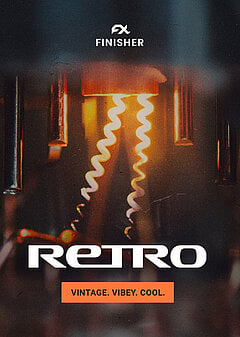Golden Mixing Rules of Hip Hop
How to tackle a hip hop mix, from individual instruments to designing a perfectly balanced record that shines.
MARCH 20TH, 2022
Read carefully until the end of this article to get an idea of how to mix Hip Hop, including the beat, the vocals and bass.
How to mix your drums
Perhaps unsurprisingly, one of the first things you’ll want to nail down is the kit: your kick, snare, hi hats, and other central percussion. If you come from an EDM background in particular, there are some deeply ingrained habits you’ll need to break; let’s get into it.
The basic approach to the core drum kit in EDM, especially heavier genres like dubstep, is to make them “larger than life”: kicks that span the entire frequency spectrum and have an extremely present high end, snare with a meaty bottom that hit you in the chest, splashy hats that fill the background, etc. By contrast, hip hop drums are much tighter, more controlled. There will always be minor differences, but there are a few specifics that tend to hold true for different drums. Try out Beatmaker GLORY if you want a real-time look at this (and if you want to have a great hip hop / trap sound right out of the gate)!
For example, kicks: generally, you’ll find that the transient is very short, the body doesn’t stretch down to the lowest of the low bass frequencies, and the high frequencies don’t get a ton of emphasis. Often they trigger with every bass note, forming the classic “trap bass” sound, which rounds out this sound even further.
Snares are also extremely short. The transient is sharp, you generally won’t find any sort of tail or release, and the EQ settings are nearly the opposite of EDM snares. Instead of a heavy body, clean high end and some splashiness, hip hop drums have very little of their fundamental frequency, feel a little rolled off in the high end, and have a boost around 2kHz - 3kHz (Many Men (Wish Death) by 50 Cent is a great example). This provides a harsh smack and is a huge component of the genre’s sound as a whole. Save those high frequencies for the closed hi hats and keep them short, throw in some open hi hats here and there, and you’ll be able to get the essentials down!
Vocal mixing
If you don’t listen carefully, it’s easy to miss a lot of the subtle processing that hip hop vocals get (except for tuning, of course!). For example, listen to some of Eminem’s older songs like Without Me and you’ll hear a lot of vocal doubling; this can be done either on the production side (recording multiple takes and layering them together) or the mixing side (using a vocal doubling plugin).
In more modern hip hop, though not as much with older songs, you’ll also find a high shelf EQ is boosting the upper frequencies, adding a bit of “air.” While this often occurs in EDM as well, it’s worth noting that there’s less competition in the high end in hip hop, so this makes the vocals shine through even more than they would otherwise.
Arguably though, the most important aspect of vocal mixing is the leveling — if the vocals aren’t at the forefront of the mix, listeners will struggle to hear the lyrics and things will feel off. This is predominantly because hip hop is a heavily vocal-dominated genre, which is less true even for rock, EDM and other genres. Make sure the average volume is high enough, and don’t be afraid to use several compressors each series to gradually make the level more consistent. Each of the compressors should only have a few decibels of gain reduction so that the dynamics are preserved, and the cumulative effect is powerful — Slate Digital has a range of analog-modeled compressors that work seamlessly in conjunction if you want to recreate this effect.
Fine-tuning the bass
Before approaching mixing, listen carefully to the contour of each bass note: typically they’re not sustained but have a very long release, making hip hop bass lines quite dynamic. We alluded to this earlier, but this is part of the reason that bass and kick hits often occur simultaneously — to give the bass extra punch and give the kick a stronger bottom end. If this is the case in the mix you’re working on, consider grouping the kick and bass together and slapping a compressor on both, playing with the attack and release until you’re happy with the result!
If you have direct access to the bass synth patch, a great starting point is to use a triangle wave — and if you have control over the volume of individual partials, play with the second partial as that has a massive impact on the “thickness” of the bass (if you’re determined, you can also achieve a similar effect by mapping a subtractive EQ to the note number, cutting out the second harmonic). Dial it back if you want it cleaner, boost it if the mix needs some extra meat. Either way, generally you want little to no action in the high frequencies, keeping the presence of the bass only in the low end. This keeps your mix cleaner overall, though it’s a good idea to add some saturation to help it stand up to the more broadband elements of the mix.
How your chords fit into the mix
Often, you’ll be dealing with keys, guitar and / or low pass filtered sawtooth synths (there are plenty of other options, but these make up a substantial portion of hip hop songs — they keep reappearing because they work!). The first and easiest mixing decision is the overall volume level, because with hip hop the chords are typically one of the quieter aspects of the mix, sitting nicely in the background. Think of them more as decoration, while the focus goes to the drums, vocals and bass.
Apply as much low pass filtering as you see fit, because the more high frequencies that stand out, the more noticeable the chords will be, which isn’t what you’re looking for with hip hop. Summertime Magic by Childish Gambino is an excellent example of this — listen to the chorus and you’ll hear that the chords are largely being carried by one main synth sound with an enveloped low pass filter.
The main danger here is that the chords could be completely swallowed by the rest of the mix, so it’s important to find where the important information lives (primarily the mids and low mids) and cut that area away from some of the conflicting elements. Sometimes this could be the vocals, in which case you might need to “trade” frequency ranges, i.e. cutting parts of the spectrum in either the vocals or chords and boosting them in the other.
Wrapping up
We’ve covered many nuances of the different sections in standard hip hop mixes, though it’s valuable to call attention to one more aspect: depth and spacing, or reverb. Hip hop mixes tend to feel very close to the listener, preferring smaller room verbs at low wetness rather than big, dense spaces. This varies from mix to mix, and where you choose to sit on this spectrum will have a major impact on the overall feel of what you create.
Hip hop has its own unique feel with many different interpretations, and has a level of intimacy and punch that’s hard to come by in other genres. It’s largely defined by powerful drum beats, backing tracks and of course lyrics, and presents an excellent opportunity to highlight all of them since hip hop arrangements tend to be quite sparse. Try finding this level of freedom with a 100-track EDM project!
Working with a smaller number of instruments can be a welcome change, and offers a chance to explore the full extent of each instrument’s capabilities more than you can in other genres. Have fun, experiment, and embrace new approaches to mixing and production!
About the Author
Harry Lodes is a copywriter, marketing consultant and content writer for audio and ecommerce brands. He lives in the Philadelphia area, releasing Eastern/Western hybrid EDM under the artist name KAIRI hearkening back to his roots in Berklee College of Music.
Stay up to date
Sign up and we’ll send you an e-mail with product news and helpful stuff every now and then. You may unsubscribe at any time.
Defy Limits
We develop software solutions that enable people to create, consume and interact with music.



